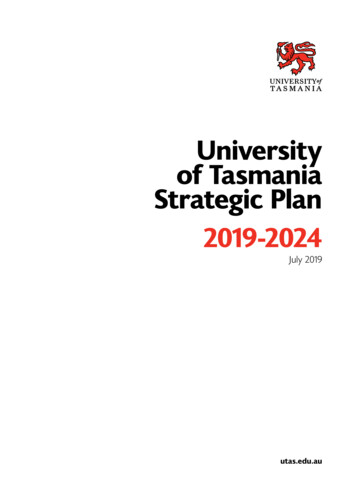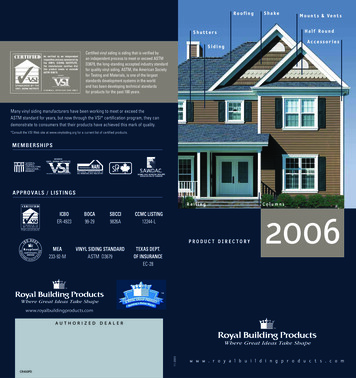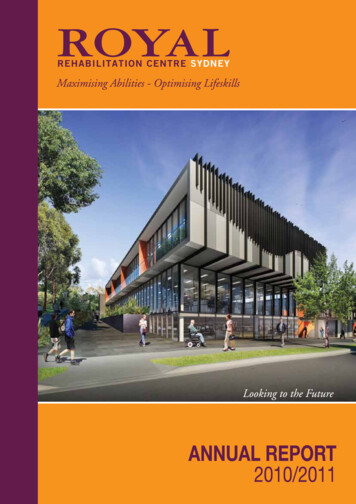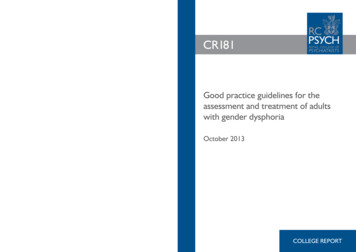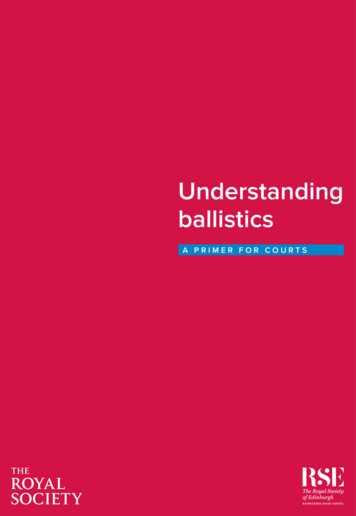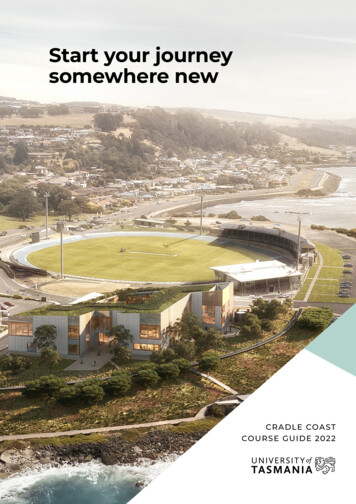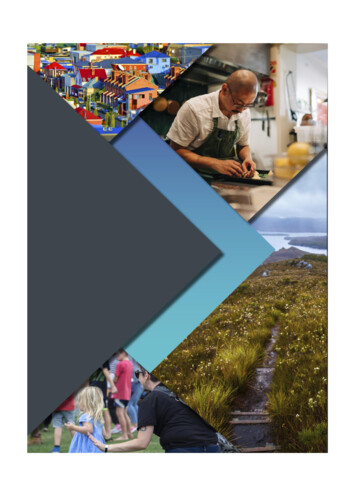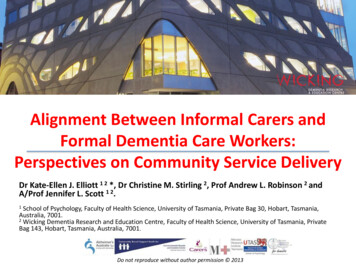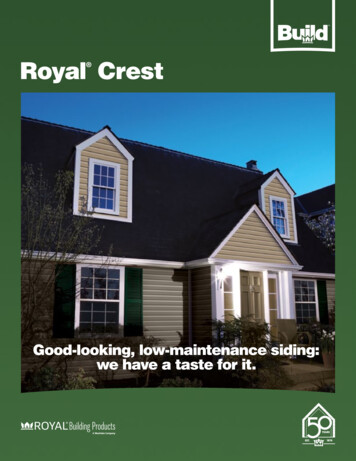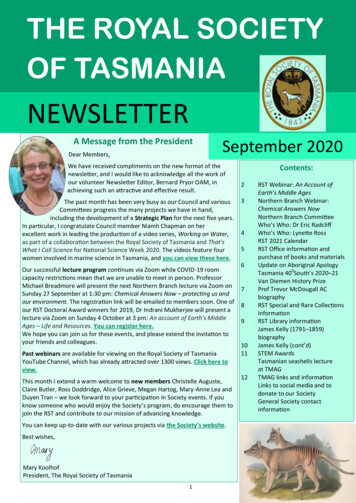
Transcription
THE ROYAL SOCIETYOF TASMANIANEWSLETTERA Message from the PresidentDear Members,September 2020We have received compliments on the new format of thenewsletter, and I would like to acknowledge all the work ofour volunteer Newsletter Editor, Bernard Pryor OAM, inachieving such an attractive and effective result.The past month has been very busy as our Council and variousCommittees progress the many projects we have in hand,including the development of a Strategic Plan for the next five years.In particular, I congratulate Council member Niamh Chapman on herexcellent work in leading the production of a video series, Working on Water,as part of a collaboration between the Royal Society of Tasmania and That'sWhat I Call Science for National Science Week 2020. The videos feature fourwomen involved in marine science in Tasmania, and you can view these here.Our successful lecture program continues via Zoom while COVID-19 roomcapacity restrictions mean that we are unable to meet in person. ProfessorMichael Breadmore will present the next Northern Branch lecture via Zoom onSunday 27 September at 1:30 pm: Chemical Answers Now – protecting us andour environment. The registration link will be emailed to members soon. One ofour RST Doctoral Award winners for 2019, Dr Indrani Mukherjee will present alecture via Zoom on Sunday 4 October at 3 pm: An account of Earth's MiddleAges – Life and Resources. You can register here.We hope you can join us for these events, and please extend the invitation toyour friends and colleagues.Past webinars are available for viewing on the Royal Society of TasmaniaYouTube Channel, which has already attracted over 1300 views. Click here toview.This month I extend a warm welcome to new members Christelle Auguste,Claire Butler, Ross Doddridge, Alice Grieve, Megan Hartog, Mary-Anne Lea andDuyen Tran – we look forward to your participation in Society events. If youknow someone who would enjoy the Society’s program, do encourage them tojoin the RST and contribute to our mission of advancing knowledge.You can keep up-to-date with our various projects via the Society’s website.Best wishes,Mary KoolhofPresident, The Royal Society of Tasmania1Contents:23456789101112RST Webinar: An Account ofEarth’s Middle AgesNorthern Branch Webinar:Chemical Answers NowNorthern Branch CommitteeWho’s Who: Dr Eric RadcliffWho’s Who: Lynette RossRST 2021 CalendarRST Office information andpurchase of books and materialsUpdate on Aboriginal ApologyTasmania 400South’s 2020–21Van Diemen History PrizeProf Trevor McDougall ACbiographyRST Special and Rare CollectionsinformationRST Library informationJames Kelly (1791–1859)biographyJames Kelly (cont’d)STEM AwardsTasmanian seashells lectureat TMAGTMAG links and informationLinks to social media and todonate to our SocietyGeneral Society contactinformation
Dear Royal Society of Tasmania members and supporters,You are invited to a Zoom webinar on 4 October 2020 at 3:00 pm.An account of Earth's Middle Ages –Life and ResourcesWebinar Speaker: Dr Indrani Mukherjee is a Postdoctoral Researcher inGeochemistry at CODES, University of Tasmania who won an RST DoctoralAward in 2019. She completed her PhD in 2018 from the University of Tasmaniaunder the supervision of Prof Ross Large. Indrani acquired her BSc (Hons) andMSc in Geology degrees from the University of Delhi, India.About the presentation: Indrani’s PhD involved understanding pyrite traceelement and sulphur isotope geochemistry of Precambrian marine black shales using LA-ICP-MS and SHRIMP-SItechniques. The research focussed on nutrient-productivity cycles in past oceans and atmosphere-ocean redoxstate in the context of biological evolution in the Proterozoic era. Pyrite chemostratigraphy was also used forassessing mineralisation potential of black shales.This presentation will expand on the research foundations built over the course of Indrani’s PhD targeting bothfundamental and applied aspects of geochemistry. The former involves advancing our knowledge of Precambrianatmosphere-ocean dynamics in shaping the course of early evolution. The latter involves utilisation of thegeochemical data combined with statistical tools, for applications such as biogenicity tools, predictive modelling,and mineral exploration.Register in advance for this webinar.After registering, you will receive a confirmation email containing information about joining the webinar.Tips for joining a Zoom webinarThis will be my first experience with Zoom. What do I do? A link will be provided so that you can register in advance. Once you have registered, you will be emailed a link to view the lecture. Click on that link a few minutes before the advertised start time and follow theprompts. What do I need to participate?You can join from any desktop computer, laptop, tablet or smartphone.You do not need to have a Zoom account.You can participate in the webinar from anywhere in the world as long as you have an internet connection.I've participated in small Zoom meetings where you can see and hear each person. Will it be like that? A lecture is a bit different. Attendees will be in ‘view only’ mode. You will be able to see and hear the host, and the speaker and their slides.Will I be able to ask a question? Yes. At the end of the lecture, type your question using the Q&A button at the bottom of your screen. The host will ask the speaker a selection of these questions. Verbal questions are not available for this lecture.What if I am late? If you are late, you can still join the lecture.Will the lecture be recorded? Yes, the lecture will be recorded. After about a week, it will be available for viewing on the RST YouTubechannel.More questions? Find the answers at: https://zoom.usHow do I leave the meeting? The host will close the meeting at the end.2
RST Northern Chapterinvites you to a Zoom webinar onChemical Answers Now:protecting us and our environmentby Professor Michael Breadmoreon 1.30 pm Sunday 27 September 2020Prof Breadmore is pioneering the development of portable and transportabletechnology to provide chemical information when and where the sample iscollected. Applications include the detection of home-made explosives at airports,the continuous monitoring of nutrients in our rivers, and more recently, whether we can use these to detectviruses.After public education in Northern Tasmania, Prof Breadmore graduated from the University of Tasmania with BSc(Hons), PhD, DSc. He has made a continued and sustained contribution towards miniaturised analytical technologyfor clinical, forensic, environmental and food applications at UTAS. He was one of three finalists in the EurekaOutstanding Young Researcher Award (2011); has been listed in the Analytical Scientist’s powerlist of the top 100analytical chemists in the world (2014, 2017, 2019); and is the Director of the Australian Centre for Research onSeparation Science.Click to register in advance for this webinar.After registering, you will receive a confirmation email containing information about joining the webinar.Generously supported byNorthern Branch Committee Who’s WhoDr Eric VR Ratcliff OAM, FRANZCP, MBBSEric Ratcliff was born in Launceston in 1938, completed secondaryeducation at Launceston High School and graduated MBBS fromthe University of Queensland in 1964. He qualified as a consultantpsychiatrist in 1976 and became a Fellow of the Royal Australianand New Zealand College of Psychiatrists in 1981.He was a long-serving General Councillor of the College, chaired anumber of bi-national committees, and was awarded the CollegeMedal of Honour in 2006. He has served a number of terms asChair of the Northern Branch of the Royal Society.In addition to continuing psychiatric and medico-legal practice inLaunceston, he is a recognised architectural historian, and haspublished on aspects of nineteenth century architecture anddesign in Tasmania and in England and on hospital and medicalhistory in Tasmania.He was honoured with an OAM in 2004 for services to psychiatryand architectural conservation. He is Northern Branchrepresentative on The Royal Society of Tasmania Foundation.Right: Dr Eric VR Ratcliff OAM, FRANZCP, MBBS pictured withhis wife, Patricia, after the Order of Australia ceremony wherethey each were conferred with an OAM.Photo courtesy of The Examiner.3
Lynette RossLynette Ross was born in 1954 and grew up on the South Island of New Zealand.She moved to Australia in her 20s and, after living in various parts of the country,settled in Tasmania. She undertook a Bachelor of Arts degree majoring in historyand archaeology; the latter through the University of New England. Central toher Honours degree in history was a thesis on convict death at Port Arthur whichled to a re-interpretation of the Isle of the Dead.Lynette has a varied career history, including Heritage Officer at the Port Arthursite, as well as research roles and other positions at the University of Tasmania.She has also held the position of coordinator of operations at the historicSaumarez Homestead in NSW and other freelance roles. Her special interest isthe history and archaeology of Australia’s colonial period.Lynette volunteers at the Queen Victoria Museum and Art Gallery in NaturalSciences working on special projects. She joined The Royal Society of Tasmania in2017, and in 2018 she joined the Northern Branch Management Committee.Currently Lynette is a member of the Branch’s Centenary Sub-committee.Lynette has enjoyed an active life of horseriding, scuba diving, travel, all subjects relating to the past, reading andthe natural world. Lynette is now retired but occupied with completing writing projects related to the colonialperiod. Her history of Launceston’s Government Cottage is due to be published in 2020.Launceston's Government Cottage was erected by William Paterson in about 1807 on what is now the southeastern section of City Park. It served as the official residence in the north and was at times utilised for purposesoutside its official function; for example, in 1836 GeorgeArthur approved it as accommodation for the femaleimmigrants from the Amelia Thompson; and in 1838, Sir JohnFranklin lent the premises to the Launceston HorticulturalSociety for their exhibitions. In 1848, it was rented to theRev John Yarker, the first of a succession of tenants. Despiteattempts to have the building renovated or renewed, Government Cottage remained a rental property until 1885 when itwas handed over to the Launceston Municipal Council. Thebuildings, much dilapidated, were demolished and the landamalgamated into the park. By Lynette Ross, Companion toTasmanian History website. (Photo courtesy The Examiner.)Royal Society 2021 CalendarFeaturing 13 watercoloursby Francis Guillemard Simpkinson de WesselowCalendar size: 220 mm high x 297 mm wideRetail price: 19.95 plus postage and handling as applicable. Orderfrom our website.Members of the Royal Society can also order from the website or RSToffice at the discounted price of 18.00.For orders of 10 or more: 15.00 per copy (plus postage and handling ifapplicable).Purchase direct from the Royal Society Office on Wednesday mornings9:00 to 12:00 noon or email royal.society@tmag.tas.gov.au or phoneWednesday mornings on 03 6165 7014.While stocks last – 2020 Calendar discounted2020 Calendar discounted to 8.50 if purchased directly from the Royal Society Office on Wednesdaymornings.Call in, phone or email. Order by post or from the website for 12.00 per copy (including postage andhandling within Australia).4
Revised Society Office ArrangementsIt is now possible to visit the Royal Society office on Wednesday mornings 9:00 am to midday. It is necessary toenter the Custom House building from the Davey Street entrance and register at the Visitors’ desk. TMAG’sSafety Plan requires all visitors’ details to be recorded.Currently, up to three people may be present in the RST office at any one time; however, membership matters andbook purchases can still be transacted. A phone call prior to your visit will help with arrangements.Please phone between the hours of 9:00am – 12 noon on a Wednesday morning on 03 6165 7014.Main contact:GPO Box 1166Hobart TAS 7001Email: royal.society@tmag.tas.gov.auNorthern Branch contact:Christine Beswick, Secretary:0417 330 118PO Box 47 Perth TAS 7300Membership forms and renewals can either be posted to the Post Box (see above) clearly marked ‘Royal Society ofTasmania’ or completed and emailed to the address above.Book and calendar sales are still available either through the RST shop, on our web page, or by email and phonethrough the office.10% discount on these books to Members:Poles Apart: Fascination, Fame and FollyHardcover and SoftcoverMapping Van Diemen's Land and the Great BeyondHardcover and SoftcoverThe Library at the End of the WorldHardcover and SoftcoverCharles Darwin inHobartSoftcoverCalendars2020 edition at rightDavid Wilson, Honorary Treasurerdwilson.tas@gmail.com5
Aboriginal Apology UpdateThe Aboriginal Engagement Committee (AEC) has been continuing in assisting Council in working toward anapology to Tasmanian Aboriginal people. The wording of the apology has received further attention fromCouncil who are working to finalise it in the coming weeks. We have had positive and constructive discussionswith senior members of the Tasmanian Museum and Art Gallery (TMAG) regarding their own apology. We arecontinuing discussions with the plan of offering paired apologies at a shared event.We will inform members further as details are agreed and finalised by TMAG and RST Council. The AEC has alsobriefed the incoming members of Council regarding the history of the work of the AEC dating back to 2016and, especially, the recent consideration of the RST entering into a Reconciliation Action Plan (RAP) or RAP-likearrangement. Council are considering this matter.Finally, Prof Greg Lehman has stepped down from his role as co-chair of the AEC while remaining an activemember. The AEC thanks Greg very much for his insight and co-leadership of the AEC and looks forward toongoing partnership with him.Prof Matt KingThe Van Diemen History Prize 2020–21Entries have now opened for the Forty South Publishing biennial ‘VanDiemen History Prize’. Good writing about history can be engaging,insightful, poignant or intriguing, but the underlying research will alwaysbe authentic and rigorous. The biennial Van Diemen History Prize fostersquality writing about Tasmanian history for articles aimed at a general audience.Open to Australian citizens or Australian permanent residents, the prize is for articles up to 3,000 words on anyaspect of Tasmanian history prior to the 21st century. The winner will receive a cash prize of 500 and publicationin Forty South magazine. A selection of the best entries will be published in The VanDiemen History Anthology 2021. Entries close September 21, 2020.Entry fee: 20 per article. Click for online entry form.2020 Judges: Professor Stefan Petrow, Associate Professor Kristyn Harman, Paige Gleeson (2018–19 winner) andChris Champion (Editor, Forty South Tasmania).* Please note: Previously published articles are eligible for entry but must be free of copyright for publication inForty South magazine and the anthology.6
Professor Trevor McDougall ACFRS FAA FAGU FInstP FRSN FAMOS (- yes, he really does have that many lettersafter his name!). Trevor (pictured left) would be well known to many fellowmembers of The Royal Society of Tasmania. He won the Society’s M R BanksMedal in 1998 which is awarded every second year to honour outstandingacademic achievement by a mid-career scientist.Trevor followed that up in 2013 by being awarded The Royal Society ofTasmania Medal which is awarded every fourth year for substantial originalresearch in the natural sciences. In fact, Trevor is one of Australia’s mostawarded scientists having won numerous prestigious national and international awards. A full list can be found here.This was capped off by the award of Companion of the Order of Australia in2018 for eminent service to science, and to education, particularly in the areaof ocean thermodynamics, as an academic, and researcher, to furthering theunderstanding of climate science, and as a mentor of young scientists.Trevor is a physical oceanographer who specialises in understanding theprocesses by which water bodies mix and transfer heat in the oceans. Withcolleagues at CSIRO in Hobart, where he worked for 30 years rising to theposition of CSIRO Fellow, he discovered four new oceanic mixing processesand has pioneered the concept of neutral surfaces along which lateral mixingoccurs. Trevor has developed equations for these processes which are nowincorporated into complex models that are used to quantify the important roleof the oceans in heat flow and hence climate change.It might appear from all these awards and his election to fellowship of theAustralia Academy of Science and Royal Society of London that Trevor’s careerhas been without hiccups but that would be far from the truth. Several of hismost important scientific papers were rejected when they were firstsubmitted, which he acknowledges with great pride.Trevor tells younger staff that “if you aren’thaving papers rejected by the top journals, thenyou aren’t trying hard enough”.His career at CSIRO was cut short due to reducedgovernment funding for climate science. Along withsome other top scientists at CSIRO, Trevor was maderedundant, but in his inimitable style he took this in hisstride and was promptly employed by the University ofNew South Wales as Professor (later Scientia Professor)of Ocean Physics in the School of Mathematics andStatistics.Images above supplied by teos-10.orgTrevor was able to establish a new research group withfunding from a Laureate Professorial Fellowshipawarded by the Australian Research Council in 2016which provided support for five years of research withfour postdoctoral fellows, and his research continues to prosper.After attending Unley High School in Adelaide, Trevor graduated from the University of Adelaide in MechanicalEngineering in 1973. He then went to the University of Cambridge to do a Doctor of Philosophy (obtained in 1978) andthen (for a change of pace) he went to the Australian National University, where, in his spare time, he undertook aGraduate Diploma in Economics (awarded in 1982).This educational path may not have happened at all if Trevor followed the dictates of his family who were members of aclosed religious sect called the Exclusive Brethren. The sect forbade marrying or having friends with anyone who did not7
belong to the sect and also forbade listening to the radio, watching TV or even using a computer. Trevor eventuallycame to the painful decision that he could no longer remain in the sect even though it meant severing ties with hisfamily and friends. That he could make this choice, at age 21, says anenormous amount about Trevor’s determination and sense of values.Young Trevor (as he is referred to by colleagues) is a strong believer inboth a healthy mind and a healthy body. He often rides his bike towork, regularly goes for a jog and he is a keen bushwalker. Mostrecently he completed the Western Arthurs traverse with friendswhich he admits was pretty challenging at times. He can be a larrikinand is always happy to play a practical joke. One of his delights isstanding on his head (not bad at 67!) - see right.Trevor’s music tastes are eclectic: he particularly likes country music,especially Slim Dusty and Smokie.Trevor and his wife, Brita, have maintained homes in Sydney andHobart with constant travel between the two for work and for maintaining family connections. It is rather telling that they chose to returnto Hobart just in time to avoid the closure of State borders when theCOVID-19 pandemic struck. He continues to write scientific papers andcarry out work remotely as well as performing his added duties as thenew President of the International Association for the PhysicalSciences of the Oceans (IAPSO).Article by John VolkmanLeft: Prof Trevor McDougall AC picturedwith his wife, Brita, in front of The RoyalSociety of Tasmania Honour Board afterreceiving The Royal Society of TasmaniaMedal in 2013.The Society’s Special and Rare CollectionsEnjoy some jigsaws created by Heather Excell from the treasures of the UTASSpecial and Rare Collections, including a map jigsaw from the Royal Society ofTasmania Map Collection: JigsawsThese images represent a very small sample of the cultural and historical recordsheld in the collection.Explore the collections further through the online archive and website.8
Access to The Society’s Libraryto comply with COVID-19 restrictionsThe Library is open.Special & Rare Collections (5th floor, Morris Miller Library at UTAS Sandy Bay campus) including TRSTLibrary is open and asks that all visitors and researchers comply with the following COVID-safe practices: Please make appointments via special.collections@utas.edu.au to assist with managing maximumoccupancy requirements. Opening hours are 10am to 5pm, Monday to Wednesday, closed for lunch 12:30 – 1:30 pm. Maximum occupancy of two visitors at any one time and must be adhered to. You are required to maintain the recommended 1.5m physical distance. Make sure you have had your temperature checked before entering the Library. Temperature checks will be undertaken at the entrance to Morris Miller Library. If you are not a staff member or student at UTAS, you will need to sign in on entry to Morris Miller Library toenable contact tracing. The Library is providing hand sanitiser, cleaning wipes and carrying out additional cleaning. If you are feeling unwell, please do not come to the Library.Library staff will continue answering all email enquiries and can scan and email requests as needed, so if you don’twish to visit the Library in person, there is no need. We will also be quarantining materialhandled by researchers and other visitors for 72 hours, in line with UTAS Libraries’ COVID-safe practice.Any queries please contact special.collections@utas.edu.auJuliet Beale, Senior Librarian, CollectionsLibrary Services Academic DivisionUniversity of TasmaniaJames Kelly (1791–1859)James Kelly sealer, pilot and harbourmaster, was born at Parramatta.Apprenticed to Kable & Underwood in 1804, he is believed to be the first whiteAustralian-born child to become a master mariner. After his apprenticeshipwas completed in 1809, he sailed to India and on several sealing ventures toMacquarie Island and the Bass Strait. In 1814, he was appointed to sailbetween colonial ports as master of the schooner Henrietta owned by TWBirch (1774–1821), a whaler and merchant of Hobart, and later commandedBirch's brig Sophia. According to an account he wrote sometime after1821, Kelly set out in 1815 in a whaleboat on a voyage in which he circumnavigatedVan Diemen's Land and ‘discovered’ Port Davey and MacquarieAbove: Kelly Street, Hobart.Harbour.Photo ourtasmania.com.auIn 1818, with an armed detachment, he was searching the east coast of Tasmaniafor escaped convicts; he assisted in transporting convicts in the Sophia toBelow: Five Bank of Van Diemen’s Landthe newly-established penal station at Macquarie Harbour in 1821; andcheques written by James Kelly from 1829 toin 1825 he helped to set up the secondary penal station on Maria Island.1840 (plus one by a Humphrey Grey).He was appointed pilot and harbourmaster at the Derwent in 1819 andremained in that position until 1829. By then, he was actively engaged inwhaling, had an interest in several ships, was extending farmingoperations on Bruny Island, owned property and built steps at BatteryPoint and had become a well-to-do identity. He sent two of his sons toBath Grammar School in England, contributed towards the cost of building the theatre (Royal) in Campbell Street, was elected one of theDerwent and Tamar Fire, Marine and Life Assurance Company’s firstdirectors, and became a committeeman of the Anniversary Regattainaugurated by Sir John Franklin.9
But his fortunes turned. In 1834 his ship Australian waswrecked and the Mary and Elizabeth attacked by Maoris inNew Zealand. In 1831, his wife (Elizabeth Griffiths, married1812) died (- see gravestone left).Then in 1841, his eldest son, aged 21, was killed while whaling(- see gravestone below right); and his third son was drownedin theDerwentthefollowingAbove: Gravestone of Elizabeth Kelly and five of her year.children. Photo ontheconvicttrail.blogspotHit by the depression of the 1840s, Kelly was compelled toassign his properties to creditors – and accepted employmentfrom the port authorities once more. Although credited withbeing the 'father and founder of whaling' in Tasmania, he wasunable to re-enter the industry and saw others reap thebenefits. He died suddenly in Hobart and was buried inSt David’s Park. Seven of his ten children predeceased him. He is remembered through Kelly’s Steps inHobart, Kelly Basin at Macquarie Harbour, Kelly Island off Forestier Peninsula and Kelly Point on Bruny Island. Hisportrait hangs in the Queen Victoria Museum & Art Gallery, es-kelly-papersKelly, James 1920, 'First discovery of Port Davey and Macquarie Harbour', Papers & Proceedings of the Royal Society ofTasmania , pp. 160-181. y-davey-1920.pdfPretyman, ER 1971, 'Some notes on the life and times of Captain James Kelly', Papers and Proceedings of the Royal Society ofTasmania, vol. 105 , pp. 105-112.https://eprints.utas.edu.au/13417/1/1971 Pretyman Life and times Captain James Kelly.pdfRight: Narrative written and signed by James Kelly entitled ''Firstdiscovery of Port Davey and Macquarie Harbour by James Kelly".The manuscript is not dated but it was written some years after theevents described, certainly after 1821, but probably this version waswritten for serial publication in the Hobart Town Courier in 1854.It is written neatly in two notebooks composed of account ruled paper(39 x 14 cm) folder in the centre to form a booklet. Another, muchbriefer, manuscript is in the Mitchell Library and may be from an earlierdate.The narrative, as published in 1854, is obviously written long after theevents referred to, shown by such references as Macquarie “the thenGovernor of New South Wales”. There is some doubt about theaccuracy of the reminiscences.10
Tasmanian STEM Excellence AwardsDo you know someone excelling in science, technology,engineering or maths?Nominations for the 2020 Tasmanian STEM ExcellenceAwards are now open.These awards recognise the achievements and innovationsof our leading local scientific practitioners, researchers,teachers and students.There are six categories and a total prize pool of 30,000: The Premier’s Tasmanian STEM Researcher of the Year Tasmanian Young STEM Researcher of the Year The Minister’s Tasmanian STEM Innovation of the Year Tasmanian STEM Teacher of the Year for Primary Years Tasmanian STEM Teacher of the Year for Secondary Years Tasmanian STEM Communicator of the Year.Nominations can be submitted at www.stategrowth.tas.gov.au until 11:59 pm on Friday, 18 September 2020.Tasmanian SeashellsThe Friends of TMAG invite you to enjoy a recorded lecture on Tasmanian Seashellspresented by Dr Simon Grove, Senior Curator of Invertebrate Zoology at the TasmanianMuseum and Art Gallery, in conversation with Janine Combes. Click here.Left: Page 29 from The Molluscan fauna of Tasmania by theRev JE Tenison-Woods FLS, FGS, Hon Member NSW Royal Society.Below left: Photo collage of Tasmanian deep-water molluscs atTMAG taken by Dr Simon Grove.Below right: Illustration from WL May and J Hope MacPherson(1958) An Illustrated index of Tasmanian shells, GovernmentPrinter, Hobart.11
Tasmanian Museum andArt GalleryNow open Tuesday to Sunday, 10:00 am – 4:00 pm.One important change is that whilst admission to TMAGremains free, all visitors are now required to make a freeonline booking via the TMAG website. Visitors can bookan untimed ticket that is redeemable at any time during TMAG’s opening hours on the booking date,pending overall site capacity. For more information and to book, please click this link.The reopening of TMAG includes the Museum Shop. Due to the COVID-19 pandemic and restrictions, theCourtyard Café licensee has made a business decision not to reopen until September.TMAG has enjoyed being able to welcome and connect with visitorsvirtually during its closure period, and will continue to offer a range ofonline activities, resources and programs for visitors to enjoy as part ofthe TMAG from Home initiative that is available from the TMAG website.Visitors will be excited to learn about a new exhibition that is available toexplore, Exquisite Habits, featuring the botanic art of Tasmanian artistStephanie Dean.The evocative This Too Shall Pass exhibition which features portraiture and still-life works from TMAG’scollection also remains on display. In addition, TMAG’s major exhibition West: Out on the Edge has beenextended and is now on show until 18 October 2020, giving the public more chances to exploreTasmania's unique West through this captivating multi-disciplinary exhibition.Follow us on:TwitterFacebookCopyright 2020 The Royal Society of Tasmania.All rights reserved.ABN 65 889 598 100Please click andscroll way downto DONATE to ourSociety. Thankyou for yourkind support!Our mailing address is:GPO Box 1166Hobart TAS 7001Our Office location is:19 Davey StreetHobart TAS 7000Office hours: Wednesdays 9:00 am - 12:00 pm 61 3 6165 7014Visit the website12
newsletter, and I would like to acknowledge all the work of our volunteer Newsletter Editor, ernard Pryor OAM, in . Dr Indrani Mukherjee will present a lecture via Zoom on Sunday 4 October at 3 pm: An account of Earth's Middle . and in 1838, Sir John Franklin lent the premises to the Launceston Horticultural Society for their exhibitions .
